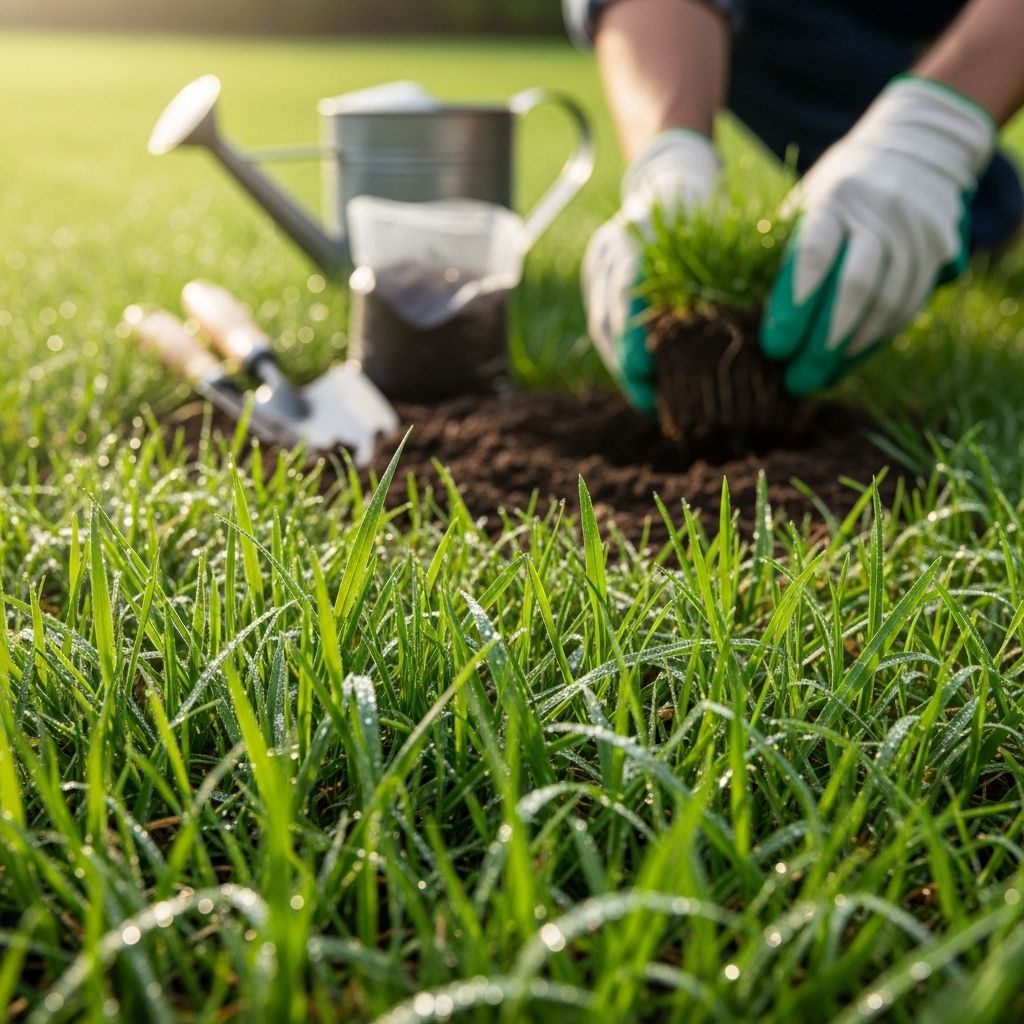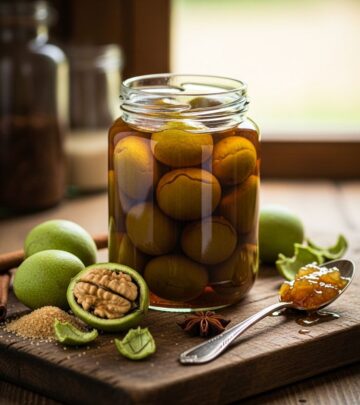Gardening 101: St. Augustine Grass—Planting, Care, and Cultivation
Enjoy an emerald-green lawn that thrives in heat, humidity, and salt-sprayed coastal areas.

Image: HearthJunction Design Team
St. Augustine grass (Stenotaphrum secundatum) is renowned for its robust growth, deep green hue, and tolerance to heat, salt, and humidity. Favored in warm coastal regions, this turf variety creates dense lawns with exceptional coverage. This in-depth guide explores St. Augustine’s characteristics, planting methods, year-round care, troubleshooting, recommended varieties, and frequently asked questions to help you cultivate a thriving lawn.
What Is St. Augustine Grass?
St. Augustine grass is a coarse-textured, warm-season turfgrass widely used for residential and commercial lawns in southern United States, especially coastal and humid subtropical areas. Its thick stolons (horizontal stems) help create a dense, carpet-like appearance, spreading rapidly to cover bare ground. Although it is drought-tolerant once established, it prefers consistent warmth, moist soil, and moderate sunlight to perform optimally.
Overview of Key Characteristics
- Botanical Name: Stenotaphrum secundatum
- Common Names: St. Augustine grass, Buffalo grass (not to be confused with North American Buffalo grass)
- Zones: USDA 8-10
- Light: Full sun to partial shade
- Soil: Fertile, well-draining, pH 6–6.5 is ideal
- Height: Grows 4–6 inches tall; mowing maintains it shorter
- Spread: Horizontal spread via stolons
- Season: Grows actively in late spring to early fall
- Color: Deep blue-green
Why Choose St. Augustine Grass for Your Lawn?
St. Augustine grass is especially well-suited to:
- Warm, humid climates: Thrives where summers are long and hot.
- Coastal areas: Tolerant of saline soils and salt spray.
- Moderate shade: Handles filtered sunlight better than some warm-season turfgrasses.
- Quick coverage: Spreads aggressively via stolons to form a dense lawn, which helps suppress weeds and fill bare patches.
Although it generates excellent ground cover, St. Augustine grass is not recommended for cold climates where winter temperatures drop below freezing for extended periods, as it lacks frost hardiness. Its rapid growth also demands regular upkeep to prevent thatch buildup and avoid an uneven lawn profile.
How and When to Plant St. Augustine Grass
St. Augustine grass cannot be grown from seed (since no commercial seed is available). Instead, lawns are established using sod, plugs, or sprigs:
- Sod: Best for instant coverage. Sod is laid over prepared soil for immediate lushness.
- Plugs: Small squares of rooted grass spaced throughout the desired area. Plugs fill in over several months and are more affordable than sod.
- Sprigs: Pieces of stolon/grass runners pressed into the soil; slower to fill in but economical for large areas.
Best Time to Plant
- Plant during warm months (spring through mid-summer), when soil temperatures are consistently above 65°F (18°C).
- Allow at least 90 days before first expected fall frost to ensure successful establishment.
Step-by-Step Planting Guide
- Prepare the site: Remove existing turf, weeds, and debris. Till the soil to a depth of 6–8 inches, correcting drainage issues and blending in organic matter or recommended amendments.
- Test and adjust soil: Aim for a soil pH of 6.0–6.5. Use lime to raise low pH, or sulfur to lower high pH, always based on a soil test.
- Lay sod, plant plugs or sprigs: Press sod firmly against the prepared soil (stagger edges like brickwork). For plugs, plant 12–18 inches apart. Water thoroughly after installation.
- Keep soil moist: Water daily (or as needed) for the first 2–3 weeks, reducing frequency gradually as roots establish.
- Avoid foot traffic: Stay off the lawn during early establishment to prevent root disturbance.
Caring for St. Augustine Grass Throughout the Year
Proper maintenance ensures a vigorous, resilient lawn. The main care routine revolves around mowing, watering, fertilizing, and weed/pest control.
Mowing
- Mow between 2.5 to 4 inches (3–4 inches for shaded areas).
- Never remove more than one-third of the leaf blade in a single mowing.
- Use sharp blades and a mulching mower; this recycles nutrients and diminishes yard waste.
- Raise the mowing height during periods of heat or drought for added stress protection.
- Start mowing in spring as soon as grass greens up; continue regularly throughout the growing season.
Watering
- Deep, infrequent watering encourages deep roots—typically 1 inch of water per week during active growth.
- Monitor for wilting or folded blades, which indicate moisture stress.
- Avoid overwatering, as this promotes diseases and shallow rooting.
- Adjust irrigation based on rainfall, heat, and soil drainage.
Fertilizing
- Base all fertilizer applications on a soil test.
- Apply a balanced fertilizer with 1 pound of soluble nitrogen per 1,000 square feet every 8 weeks (during active growing season).
- Apply lime or sulfur based on pH test results: lime for acidic soils and sulfur to lower high pH (only when air temperature is below 75°F).
- Stop fertilizing in late summer to prevent cold-weather growth that is more vulnerable to winter injury.
Weeds, Insects, and Disease Management
- Weed control: Healthy, dense lawns suppress weeds naturally. Spot treat problem areas only; avoid widespread herbicide use on sensitive new turf.
- Pest monitoring: Look for signs of grubs, chinch bugs, or armyworms. Treat affected areas promptly with appropriate measures.
- Disease management: Watch for large patch (fungal causes) and leaf spot diseases, particularly in warm, humid weather. Good drainage and proper watering routines reduce problems.
Soil and Site Preparation for St. Augustine Grass
Success starts with site and soil preparation:
- Drainage: Ensure excellent drainage to avoid soggy roots—avoid low, waterlogged spots.
- Soil improvement: Incorporate composted organic matter into sandy or heavily compacted soils.
- Eliminate existing vegetation: Remove weeds and other grasses thoroughly before planting.
- Level and grade: Smooth and gently slope the area for future mowing and to avoid standing water.
Popular St. Augustine Grass Varieties
| Variety | Key Characteristics | Best Use |
|---|---|---|
| Floratam | Vigorous growth, coarse texture, high resistance to chinch bug, sensitive to cold and shade | Full sun, high-traffic areas |
| Palmetto | Fine texture, better shade tolerance, vibrant green | Partial shade lawns, residential |
| Raleigh | Moderate cold tolerance, denser than Floratam | Transitional zones, moderate sun |
| Seville | Dwarf variety, blue-green, salt tolerant, fine textured | Coastal regions, shaded landscapes |
| Bitterblue | Improved cold tolerance, fine leaves, good color retention | Cooler warm regions, home lawns |
Selecting the right variety depends on local temperatures, shade levels, pest resistance, and aesthetic preferences.
Common Problems and Solutions
Thatch Buildup
St. Augustine’s dense runners can form a layer of decomposing matter (thatch) between the green shoots and the soil. Thatch exceeding 1/2 inch inhibits healthy growth by blocking air, nutrients, and water.
- Aerate or dethatch annually, if needed.
- Avoid excessive fertilization, which increases thatch.
Yellowing or Bare Patches
- Drought or miswatering: Adjust watering habits to deep and less frequent.
- Nutrient deficiencies: Apply fertilizer based on soil test.
- Pest or disease: Inspect for chinch bugs or fungal infections; treat accordingly.
Pest and Disease Issues
- Chinch bugs: Grass turns yellow then brown in irregular patches. Use recommended insecticides where infestations are confirmed.
- Fungal diseases (large patch, leaf spot): Appear as yellow rings or isolated brown spots. Improve aeration and reduce irrigation late in the day.
Compacted Soil
High traffic and clay soils can lead to compaction, hindering root development and water absorption.
- Core aerate the lawn in spring to loosen soil for healthier grass.
- Top-dress with organic matter to foster microbial activity.
Tips for Achieving a Dense, Healthy Lawn
- Consistent mowing and moderate fertilizing optimize density and growth rate.
- Water deeply, but infrequently, to promote deeper roots and reduce diseases.
- Avoid heavy foot traffic during establishment phases and in wet weather.
- Fill bare spots by plugging or sprigging with established St. Augustine grass runners.
St. Augustine Grass vs. Other Warm-Season Grasses
| Feature | St. Augustine Grass | Bermuda Grass | Zoysia Grass |
|---|---|---|---|
| Texture | Coarse | Fine to medium | Fine to medium |
| Shade Tolerance | Moderate | Poor | Moderate to good |
| Drought Tolerance | Moderate | Excellent | Good |
| Salt Tolerance | Excellent | Good | Moderate |
| Seed Availability | Plugs/Sod only | Seed or sod | Seed or sod |
| Frost Tolerance | Poor | Fair | Better |
Frequently Asked Questions (FAQs)
Q: Can St. Augustine grass grow in shade?
A: St. Augustine tolerates moderate shade—more than bermuda, less than zoysia—but will thin out in full, dense shade.
Q: Can I start a St. Augustine lawn from seed?
A: No, commercial seed is not available. The grass is established from sod, plugs, or sprigs.
Q: How often should I mow St. Augustine grass?
A: Mow once the grass reaches about one-third higher than your preferred height (usually every 7–14 days during active growth).
Q: What is the best fertilizer for St. Augustine lawns?
A: Use a balanced fertilizer according to soil test results, focusing on nitrogen during the peak growing season.
Q: How can I repair bare patches?
A: Use plugs or sprigs from healthy grass to fill the gaps and keep soil moist until new growth establishes.
Q: Is St. Augustine grass pet-friendly?
A: Yes, established lawns tolerate moderate pet activity, but excessive traffic and urine spots may cause damage or discoloration, which can be repaired by replanting plugs.
Final Thoughts
For lush, resilient turf in warm, humid climates, St. Augustine grass is a leading choice. Its dense, green blades create a beautiful carpet that withstands heat, moderate shade, and salts where other grasses falter. With proper soil preparation, mindful maintenance, and attention to pests or diseases, you can enjoy a thriving St. Augustine lawn for years to come.
References
- https://hgic.clemson.edu/factsheet/st-augustinegrass-maintenance-calendar/
- https://nueces.agrilife.org/files/2019/08/Maintaining-St.-Augustine-Grass-Lawns.pdf
- https://www.trianglegardener.com/how-to-grow-st-augustinegrass/
- https://scotts.com/en-us/how-to/when-how-to-plant-grow-st-augustine-grass.html
- https://www.groundsguys.com/blog/st-augustine-grass/
Read full bio of Shinta












